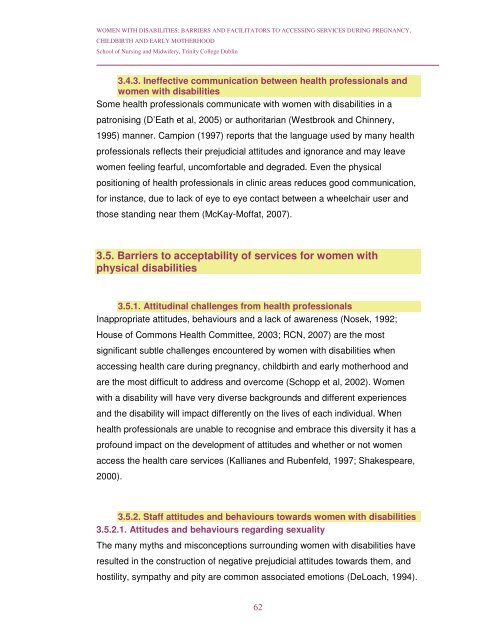Women with Disabilities: Barriers and Facilitators to Accessing ...
Women with Disabilities: Barriers and Facilitators to Accessing ...
Women with Disabilities: Barriers and Facilitators to Accessing ...
You also want an ePaper? Increase the reach of your titles
YUMPU automatically turns print PDFs into web optimized ePapers that Google loves.
WOMEN WITH DISABILITIES: BARRIERS AND FACILITATORS TO ACCESSING SERVICES DURING PREGNANCY,CHILDBIRTH AND EARLY MOTHERHOODSchool of Nursing <strong>and</strong> Midwifery, Trinity College Dublin3.4.3. Ineffective communication between health professionals <strong>and</strong>women <strong>with</strong> disabilitiesSome health professionals communicate <strong>with</strong> women <strong>with</strong> disabilities in apatronising (D’Eath et al, 2005) or authoritarian (Westbrook <strong>and</strong> Chinnery,1995) manner. Campion (1997) reports that the language used by many healthprofessionals reflects their prejudicial attitudes <strong>and</strong> ignorance <strong>and</strong> may leavewomen feeling fearful, uncomfortable <strong>and</strong> degraded. Even the physicalpositioning of health professionals in clinic areas reduces good communication,for instance, due <strong>to</strong> lack of eye <strong>to</strong> eye contact between a wheelchair user <strong>and</strong>those st<strong>and</strong>ing near them (McKay-Moffat, 2007).3.5. <strong>Barriers</strong> <strong>to</strong> acceptability of services for women <strong>with</strong>physical disabilities3.5.1. Attitudinal challenges from health professionalsInappropriate attitudes, behaviours <strong>and</strong> a lack of awareness (Nosek, 1992;House of Commons Health Committee, 2003; RCN, 2007) are the mostsignificant subtle challenges encountered by women <strong>with</strong> disabilities whenaccessing health care during pregnancy, childbirth <strong>and</strong> early motherhood <strong>and</strong>are the most difficult <strong>to</strong> address <strong>and</strong> overcome (Schopp et al, 2002). <strong>Women</strong><strong>with</strong> a disability will have very diverse backgrounds <strong>and</strong> different experiences<strong>and</strong> the disability will impact differently on the lives of each individual. Whenhealth professionals are unable <strong>to</strong> recognise <strong>and</strong> embrace this diversity it has aprofound impact on the development of attitudes <strong>and</strong> whether or not womenaccess the health care services (Kallianes <strong>and</strong> Rubenfeld, 1997; Shakespeare,2000).3.5.2. Staff attitudes <strong>and</strong> behaviours <strong>to</strong>wards women <strong>with</strong> disabilities3.5.2.1. Attitudes <strong>and</strong> behaviours regarding sexualityThe many myths <strong>and</strong> misconceptions surrounding women <strong>with</strong> disabilities haveresulted in the construction of negative prejudicial attitudes <strong>to</strong>wards them, <strong>and</strong>hostility, sympathy <strong>and</strong> pity are common associated emotions (DeLoach, 1994).62
















